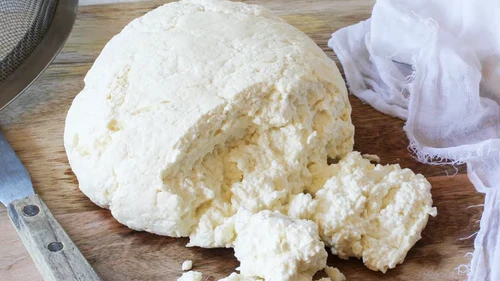Your Cart is Empty

How to make Ricotta from milk and yogurt whey
Barb Hodgens
Barb Hodgens loves to cook with alternative, healthy whole food ingredients, with a focus on gut health. Barb has overcome her own gut health issues through healthy eating. Share your ideas, comments and photos at the end of this post :)

More delicious than any store-bought ricotta!
For a while now, our customers have been asking us about using the Luvele yogurt maker to make cheese. Now, we love a challenge and – inspired by your curiosity – we embarked on some rigorous research in the Luvele test kitchen. We are delighted to report the answer to the question is a resounding ‘yes’!
Quite frankly, we are continually surprised by the versatility of our own products and in the next few weeks we will share the plentiful fruits of our research. We are super excited to bring you the creamy pleasures of German Quark, Italian mascarpone, French crème Fraiche and Indian paneer. As part of our quest, we also discovered a cheat’s method of making ricotta. This doesn't use a yogurt maker – but it was too good to pass on.
Ricotta is a rich, creamy Italian cheese consisting of delicate, moist clumps of curd. Traditionally ricotta is made by re-cooking leftover whey from Mozzarella or Provolone cheese-making. What an ingenious way of re-using a waste by-product to make yet another cheese!
Luckily for home cooks who just love ricotta, there is a simple milk-based method that doesn't require you to be a cheese maker. Technically this method is not ‘authentic ricotta' and is often called Farmer's cheese instead. Whatever you call it, this cheese is equally delicious. We are delighted with the result, which tastes perfectly milky and sweet.

With this method, the ricotta is made by adding an acidic food to milk. We used leftover whey from dripping homemade yogurt, because we have it in abundance, but white vinegar or lemon juice will do the same job. The acid in yogurt whey causes milk solids (curds) to form and separate from the liquid (whey) in the milk. These curds are what will ultimately become your ricotta style cheese after it’s been left to strain through a cheesecloth.
HOW MUCH WHEY?
Because the acidity level in homemade yogurt may vary from batch to batch, we can’t accurately specify the exact amount of whey needed to make ricotta. We used 1 ½ cups of yogurt whey, but less may have worked just as well. Unlike the lemon juice or vinegar methods, adding more whey will not adversely affect the flavour of your ricotta – so don’t worry. Allow the curds forming on the surface of your pot of milk to be the indicator. If after 2 minutes, curds have not begun to form, add another half a cup of whey. You really can’t go wrong.
LEFTOVER WHEY
If you plan to make ricotta to use up your excess whey, read on! Making homemade ricotta produces even more whey than you started with! It might seem counterproductive, I know, but you end up one and a half cups of delicious ricotta cheese, so it’s well worth it.
Ricotta cheese whey has a different acid profile to yogurt whey, so it can't be used again to make more ricotta. It also doesn't have the live probiotic bacteria of yogurt whey. Don’t throw it away though, it's still very good for you - bottle it in your fridge for up to a couple of days, and use it instead of water in soups, stews and curries, or bread and baking.

HOW TO MAKE RICOTTA FROM MILK
Produces approx. 1 ½ cups of ricotta




How to make Ricotta from milk and yogurt whey
Luvele
Rated 3.6 stars by 35 users
For a while now, our customers have been asking us about using the Luvele yogurt maker to make cheese. Now, we love a challenge and – inspired by your curiosity – we embarked on some rigorous research in the Luvele test kitchen. We are delighted to report the answer to the question is a resounding ‘yes’!
Ingredients
- 2 litres of full cream milk (whole milk)
- 1 – 2 cups of fresh yogurt whey
- ½ teaspoon sea or Himalayan salt (optional)
Directions
- Pour the milk into a large saucepan and place on the stove over medium heat.
Stir the milk as it warms to prevent it from scorching on the bottom of the pot.
As soon as foamy bubbles appear around the edges of the milk, (about 190 F), reduce the heat to low.
Pour in the yogurt whey and briefly stir to incorporate.
Continue to gently heat but do not boil. Within the next 2 minutes, small cheese curd will form and rise to the surface.
- Turn the heat off, put the lid on the pot and let the milk sit for 15 minutes.
Meanwhile, lay a piece of cheesecloth or muslin in a wide sieve or strainer, and place it over a large bowl.
After 15 minutes, remove the lid from the pot and allow the steam to escape.
Run the spoon across the bottom of the pot to lift curds that may have stuck to the bottom of the pot.
Use a slotted spoon to carefully ladle the curds into the sieve.
- Allow the curds to sit in the strainer for 15-30 minutes or until it reaches the thickness you like — whether that's soft and spreadable or firm and dry.
To push the process along, lift the edges of the cheesecloth up and around the curds and squeeze gently to remove more liquid.
The last step is to salt your cheese. The amount of salt depends on your taste, I used about half a teaspoon for this amount of cheese. Fold the curds in on themselves to mix the salt in.
- Open your cheesecloth and use a spoon to scrape the ricotta into a bowl.
Or to shape the cheese, keep it wrapped in the cloth, press the curds into a flat disc and refrigerate for an hour or so before removing the cheesecloth. Turn the cheese out onto a plate or cheeseboard.
Store the fresh homemade ricotta in an air-tight container in the fridge and use within 3 days.
PIN THIS RECIPE


How to make Ricotta from milk and yogurt whey

More delicious than any store-bought ricotta!
For a while now, our customers have been asking us about using the Luvele yogurt maker to make cheese. Now, we love a challenge and – inspired by your curiosity – we embarked on some rigorous research in the Luvele test kitchen. We are delighted to report the answer to the question is a resounding ‘yes’!
Quite frankly, we are continually surprised by the versatility of our own products and in the next few weeks we will share the plentiful fruits of our research. We are super excited to bring you the creamy pleasures of German Quark, Italian mascarpone, French crème Fraiche and Indian paneer. As part of our quest, we also discovered a cheat’s method of making ricotta. This doesn't use a yogurt maker – but it was too good to pass on.
Ricotta is a rich, creamy Italian cheese consisting of delicate, moist clumps of curd. Traditionally ricotta is made by re-cooking leftover whey from Mozzarella or Provolone cheese-making. What an ingenious way of re-using a waste by-product to make yet another cheese!
Luckily for home cooks who just love ricotta, there is a simple milk-based method that doesn't require you to be a cheese maker. Technically this method is not ‘authentic ricotta' and is often called Farmer's cheese instead. Whatever you call it, this cheese is equally delicious. We are delighted with the result, which tastes perfectly milky and sweet.

With this method, the ricotta is made by adding an acidic food to milk. We used leftover whey from dripping homemade yogurt, because we have it in abundance, but white vinegar or lemon juice will do the same job. The acid in yogurt whey causes milk solids (curds) to form and separate from the liquid (whey) in the milk. These curds are what will ultimately become your ricotta style cheese after it’s been left to strain through a cheesecloth.
HOW MUCH WHEY?
Because the acidity level in homemade yogurt may vary from batch to batch, we can’t accurately specify the exact amount of whey needed to make ricotta. We used 1 ½ cups of yogurt whey, but less may have worked just as well. Unlike the lemon juice or vinegar methods, adding more whey will not adversely affect the flavour of your ricotta – so don’t worry. Allow the curds forming on the surface of your pot of milk to be the indicator. If after 2 minutes, curds have not begun to form, add another half a cup of whey. You really can’t go wrong.
LEFTOVER WHEY
If you plan to make ricotta to use up your excess whey, read on! Making homemade ricotta produces even more whey than you started with! It might seem counterproductive, I know, but you end up one and a half cups of delicious ricotta cheese, so it’s well worth it.
Ricotta cheese whey has a different acid profile to yogurt whey, so it can't be used again to make more ricotta. It also doesn't have the live probiotic bacteria of yogurt whey. Don’t throw it away though, it's still very good for you - bottle it in your fridge for up to a couple of days, and use it instead of water in soups, stews and curries, or bread and baking.

HOW TO MAKE RICOTTA FROM MILK
Produces approx. 1 ½ cups of ricotta



PIN THIS RECIPE


Subscribe
Sign up to get weekly healthy recipes & information on new product releases.


